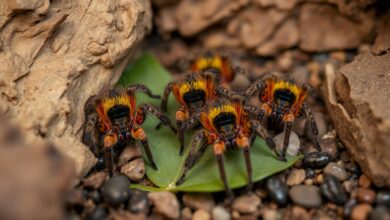How tarantula behavior changes when kept in captivity
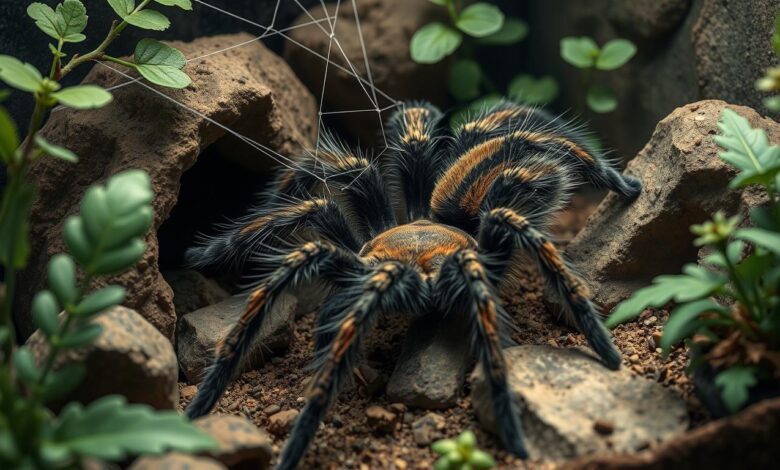
Tarantulas are fascinating creatures with unique behaviors. They have different feeding patterns and web-building skills. But, their behavior changes a lot when they are kept in captivity. This article will look at how tarantula behavior changes when they are moved from their natural habitats to a home environment.
Keeping a tarantula as a pet can be fun and rewarding. But, it’s key to know how their behavior changes in captivity. By understanding these changes, you can better care for your tarantula and create a great environment for them.
Captive tarantulas often show different behaviors than those in the wild. This includes changes in how they eat, burrow, and defend themselves. Knowing these changes helps you prepare for any challenges in caring for your tarantula.
In this article, we’ll explore the details of tarantula behavior in captivity. We’ll look at what causes these changes and how to create a good environment for your tarantula. This supports their natural instincts and keeps them healthy.
Understanding Tarantula Instincts
Tarantulas are fascinating creatures, but they are not domesticated animals. Even in captivity, they keep most of their wild instincts. Their actions are shaped by their surroundings and the seasons, affecting their activity, eating habits, and mood.
Tarantulas Retain Wild Instincts
Tarantulas still feel a strong connection to nature, even in captivity. They show behaviors that come from their wild past. This includes burrowing and defensive stances, showing their wild side.
Inability to Domesticate Tarantulas
Tarantulas can’t be domesticated like some other animals. They don’t have the right genes or behaviors for domestication. Trying to tame them has had little success, as they stay unpredictable and follow their natural instincts.
| Characteristic | Wild Tarantulas | Captive Tarantulas |
|---|---|---|
| Survival Rate | Varies, with high mortality among young spiders | Exceeds 90% under proper care conditions |
| Growth Rate | Varies by species, with periodic molting to reach adult size | Predictable growth cycles, with more frequent molting in juveniles |
| Feeding Frequency | Dependent on prey availability in the wild | Scheduled feedings based on size and species, ranging from weekly to monthly |
| Territorial Behavior | Marked by aggression towards conspecifics | Captive tarantulas often exhibit territorial behaviors when housed together |
| Behavioral Adaptations | Natural behaviors and responses to environmental cues | May develop modified behaviors, such as increased web-building or altered activity patterns |
| Longevity | Variable, depending on species and environmental conditions | Can have extended lifespans, up to 7-20 years or more, in controlled captive environments |
| Reproduction | Influenced by various environmental factors | Breeding success can be enhanced through manipulation of temperature, humidity, and diet |

In summary, tarantulas are not domesticated animals. They keep most of their wild instincts even in captivity. Their connection to nature is strong, and their behaviors are shaped by their environment and the seasons. It’s important to understand this to give them the right care and environment to thrive.
Seasonal Feeding Responses
Keeping tarantulas in captivity shows a unique change in their eating habits. Many species eat less during the cold months, even if their homes stay warm. This is because their bodies react to the environment, just like they do in the wild.
Reduced Appetite During Colder Months
As it gets colder, your tarantula might eat less. They might not want to eat at all or only take small bites. This is a big change from when it’s warmer.
This tarantula seasonal feeding is a natural instinct. It helps them save energy when food is hard to find in their natural home.
It’s important for tarantula owners to notice this change. They should not overfeed their tarantulas when they’re not hungry. This can make them sick.
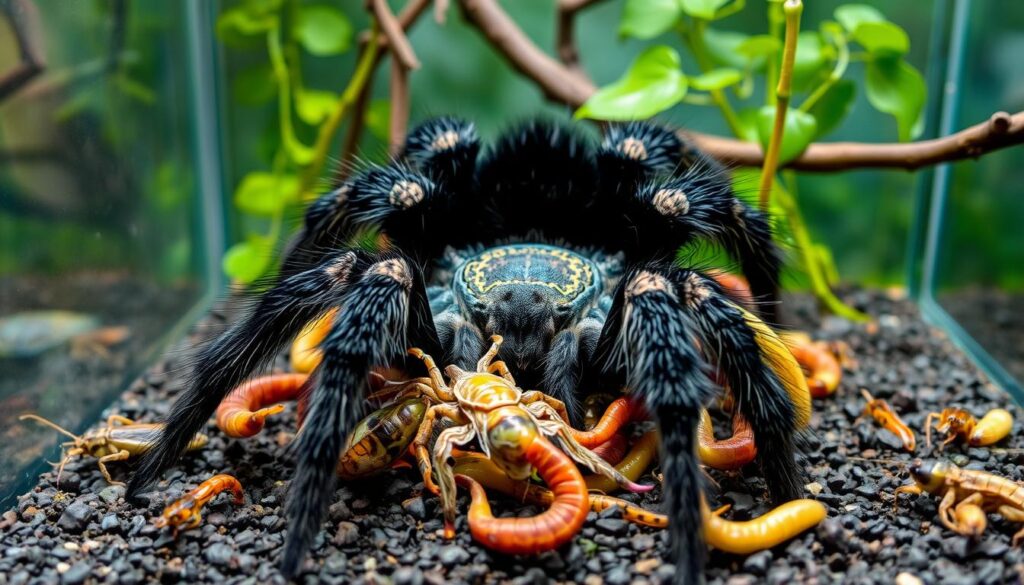
By understanding these changes, you can help your tarantula stay healthy. This way, they can thrive in their home.
Activity Levels and Isolation
When you keep tarantulas in captivity, you’ll see big changes in how active they are and how they like to be alone. In the cold months, many tarantulas will dig into the ground and stay still for a long time. This is just like they do in the wild.
Burrowing Behavior in Winter
As it gets colder, [https://tarantulaswild.com/tarantula-care/]tarantulas start digging more. They make complex tunnels and hideaways in the substrate. This helps them save energy and stay safe from harm.
Increased Surface Activity in Warmer Months
But when it gets warmer, tarantulas become more active above ground. They start to explore, interact with their space, and might even build webs or hunt more often.
Knowing about these changes in tarantula activity levels captivity, tarantula burrowing captivity, and tarantula surface activity captivity is key. It helps you give your tarantula the best care and environment for them to do well.

Metabolic Changes
Tarantulas in captivity show big changes in how they metabolize compared to those in the wild. These changes are often tied to how they eat and move while in captivity.
Tarantulas need the right temperature and humidity to keep their metabolism in check. In the wild, they face changes with the seasons. But in a captive setting, these natural changes can be different, affecting their behavior and health.
| Metabolic Parameter | Tarantulas in Captivity | Tarantulas in the Wild |
|---|---|---|
| Metabolic Rate | Reduced during colder months | Fluctuates seasonally |
| Feeding Behavior | Reduced appetite during colder periods | Varies with availability of prey and environmental conditions |
| Activity Levels | Decreased during winter, increased in warmer months | Influenced by seasonal changes and resource availability |
These changes in metabolism are key to why tarantulas behave differently in captivity. Knowing about these changes helps us care for them better. It ensures they thrive in their artificial home.

 Strategies tarantulas use to escape dangerous situations
Strategies tarantulas use to escape dangerous situations
Environmental Cues
Even in a controlled, indoor setting, tarantulas are very sensitive to their environment. They can feel changes in temperature, humidity, and other natural factors. This sensitivity helps them adjust their behavior, even in a stable enclosure.
Sensitivity to Outdoor Conditions
Tarantulas can sense and react to small changes in their surroundings. They notice temperature and humidity changes, even in a captive setup. This tarantula sensitivity shows their ability to adapt, honed over generations.
| Environmental Factor | Tarantula Behavioral Response |
|---|---|
| Temperature Changes | Adjust activity levels, feeding patterns, and metabolic processes |
| Humidity Fluctuations | Modify burrowing and web-building behaviors |
| Seasonal Variations | Exhibit changes in feeding, molting, and reproductive activities |
Understanding tarantula environmental cues helps create better environments for them. This knowledge improves their well-being and our appreciation for their adaptations. It shows how they can thrive in both the wild and captivity.

How tarantula behavior changes when kept in captivity
Tarantulas are fascinating creatures. But, their behavior changes a lot when they live in captivity. It’s important to know these changes to care for them well.
One big change is how they eat. Wild tarantulas eat when they can, but captive ones eat more regularly. This is because they always have food and don’t have to hunt.
Another change is how active they are. Wild tarantulas hide a lot, especially when it’s cold. But, captive ones move around more, especially when it’s warm.
| Behavioral Aspect | Wild Tarantulas | Captive Tarantulas |
|---|---|---|
| Feeding Patterns | Erratic and Unpredictable | Consistent Appetite |
| Activity Levels | More Burrowing and Concealment | Increased Surface Activity |
| Molting Behavior | Unpredictable Timing | More Predictable Molting Schedule |
| Web-Building Habits | Complex, Elaborate Webs | Simplified, Less Extensive Webs |
Captive tarantulas also molt more predictably than wild ones. And, they build simpler webs than in the wild.
Knowing these changes helps keep tarantulas happy and healthy in captivity. By adjusting their environment and care, we can make their lives better.
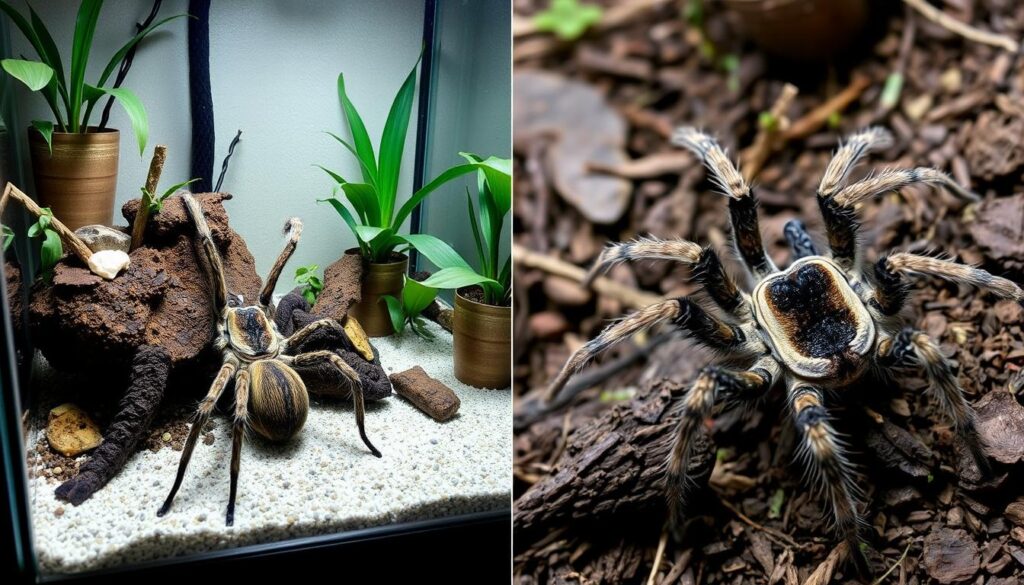
Molting Behavior
Tarantulas go through a key process called molting. This lets them shed their old skin and grow. If you keep a tarantula as a pet, you might see changes in how it molts. Knowing the signs of pre-molt helps you care for your tarantula during this time.
Pre-Molt Signs
Before a tarantula molts, you’ll see certain signs. These signs show it’s getting ready to shed its skin. Look out for:
- Decreased appetite – Your tarantula might not want to eat before molting. It saves energy for the process.
- Reduced activity – Tarantulas often hide or become less active before molting.
- Darkening of the exoskeleton – The tarantula’s skin might look darker as a new one forms.
- Abdomen swelling – The tarantula’s belly might look bigger as it prepares to shed its skin.
Watching for these tarantula pre-molt signs helps you prepare for molting. This makes the tarantula molting captivity experience smoother for your pet.
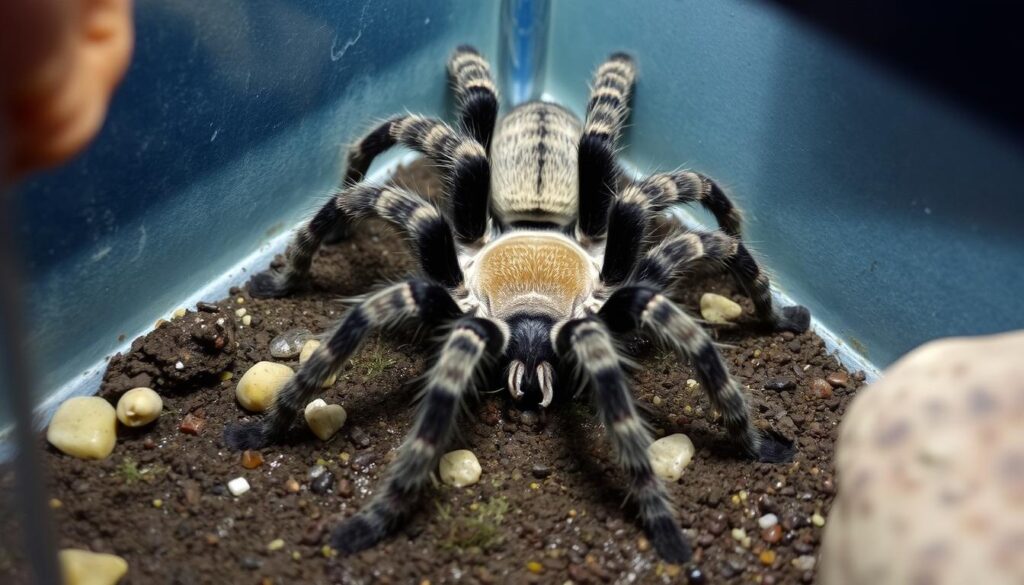
Territorial Displays
As captive tarantulas adjust to their new homes, they show interesting territorial behaviors. They naturally want to mark and protect their space, even in a human-made home. Captive tarantulas may display threats or aggression to show they’re in charge.
It’s key for tarantula owners to understand these behaviors. This knowledge helps create a peaceful home for them. By noticing these displays, owners can adjust the space or add new things. This reduces fights between tarantulas.
Threat Postures
One common display is the threat posture. Tarantulas will stand tall, show their fangs, and sometimes hiss. This warns others to stay away from their territory.
Aggressive Behaviors
In some cases, tarantulas may fight to prove who’s boss. They might lunge, bite, or try to wrestle. This happens when there’s not enough space or when a new tarantula joins.
Knowing and respecting tarantulas’ territorial nature helps owners create a good home for them. With the right setup, tarantulas can live well and stay true to their natural ways.

Web-Building Habits
Tarantulas are known for their amazing web-building skills. These skills are key to their survival and behavior. But, when kept in captivity, their web-building habits change a lot. It’s important to understand these changes to care for your tarantula well.
In the wild, tarantulas build webs for many reasons. They use webs to catch prey, make shelters, and even find mates. But in captivity, their web-building can change. Some tarantulas might build webs less often or in different ways.
Captive tarantulas often build simpler webs or don’t build webs at all. This change is because they don’t need to hunt as much in captivity. They also miss the environmental cues they get in the wild.
| Tarantula Web-Building in Captivity | Tarantula Web-Building in the Wild |
|---|---|
| Reduced frequency or complexity of web-building | Intricate web constructions for various purposes |
| Simpler web structures or abandonment of web-building | Sophisticated webs for prey capture, shelter, and signaling |
| Lack of environmental cues to stimulate web-building | Responsive to natural environmental factors |
Knowing about tarantula web-building behavior changes in captivity helps us better care for them. By creating the right environment, we can encourage natural web-building. This ensures your tarantula is happy and healthy in its home.
 How tarantulas use their venom and other tactics to prey
How tarantulas use their venom and other tactics to prey

Hunting and Feeding Patterns
Tarantulas are fascinating predators with unique hunting and feeding habits. These behaviors are key to their health, especially in captivity. Their instinctive hunting and prey preferences can change, affecting their feeding patterns and health.
In the wild, tarantulas hunt with skill, using their senses and quick reflexes. But in captivity, their hunting skills may not be as sharp. They might become hesitant or passive, refusing to hunt their usual prey.
This change in behavior is due to the lack of natural stimuli and challenges in captivity. The controlled environment can reduce their activity and motivation to hunt.
- Tarantulas in captivity may prefer smaller, less threatening prey species, such as crickets or mealworms, over larger, more challenging prey they would encounter in the wild.
- The frequency and duration of feeding may also change, with some tarantulas becoming less enthusiastic about consuming food on a regular schedule.
It’s important for tarantula owners to understand these changes. This knowledge helps them provide the right care and environment for their pets.
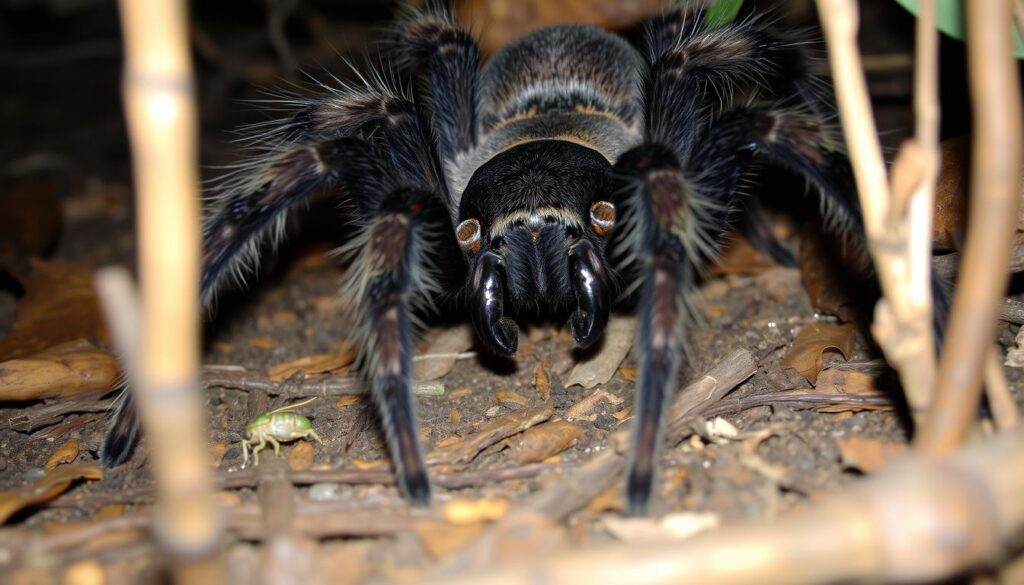
By creating a habitat that mimics their natural environment, owners can help tarantulas thrive. This ensures they can hunt and feed naturally, making their captivity experience fulfilling.
Defensive Mechanisms
Tarantulas have amazing ways to protect themselves from danger. These behaviors can be seen in both wild and captive tarantulas. One key behavior is the tarantula’s threat posture. When they sense danger, they may stand tall, flick their hairs, or show other scary moves to scare off threats.
Threat Postures
Captive tarantulas show different threat postures to defend themselves. They might stand tall, flick their hairs, or look bigger by standing on their hind legs. These actions warn potential threats that the tarantula is ready to defend itself.
- Raising front legs: Tarantulas lift their front legs to look bigger and more aggressive.
- Flicking urticating hairs: They use special hairs on their belly to irritate and scare off threats.
- Rearing up on hind legs: In rare cases, they stand up on their hind legs to look even bigger and scarier.
These postures show how well tarantulas defend themselves. Even in captivity, they still show these natural behaviors. It’s a reminder of their wild nature and the importance of being careful around them.

| Defensive Behavior | Description |
|---|---|
| Raising Front Legs | Tarantulas lift their front legs to look bigger and more intimidating, showing they’re ready to defend themselves. |
| Flicking Urticating Hairs | Many tarantulas have special belly hairs that they flick towards threats, causing irritation and keeping predators away. |
| Rearing Up on Hind Legs | In extreme cases, captive tarantulas stand up on their hind legs, making themselves look even bigger and more intimidating. |
These defensive mechanisms show how tarantulas have adapted to survive. Even in captivity, we can see these amazing behaviors. It’s important to understand and respect these behaviors to handle tarantulas safely and responsibly.
Reproduction and Egg-Sac Care
Reproduction and egg-sac care in captivity differ from the wild. Captive tarantulas may change their mating rituals and breeding cycles. This can affect their reproductive success.
The controlled environment in captivity plays a big role. Unlike wild tarantulas, they don’t get natural cues for breeding. This can disrupt their cycles, causing them to breed at odd times or skip seasons.
Also, captive tarantulas might not care for their egg sacs as they do in the wild. In the wild, they weave protective egg sacs and guard them fiercely. But in captivity, some may neglect or even eat their egg sacs, lowering hatching rates.
To help captive tarantulas reproduce and care for their egg sacs, owners need to mimic their natural environment. Adjusting temperature, humidity, and lighting can encourage their natural breeding and nesting behaviors.

Understanding tarantula reproduction and egg-sac care in captivity is key for keeping a healthy tarantula population. By knowing their unique needs and behaviors, enthusiasts can support their breeding efforts.
Individual Temperament Variations
Not all captive tarantulas behave the same way. Each one has its own unique personality and how it reacts to being kept in captivity. Understanding this is key to giving your tarantulas the best care.
Some tarantulas are more outgoing and active. Others are shy and prefer to stay hidden. The tarantula temperament captivity can vary greatly from individual to individual. This means you might see different behaviors, like how they eat, build webs, and defend themselves.
It’s important for tarantula lovers and caretakers to know these differences. By paying attention to each tarantula’s personality, you can make their environment just right for them. This helps them stay healthy and happy in captivity.

The individual tarantula temperament variations show how complex and diverse these creatures are. By accepting and working with these differences, you can have a fulfilling experience with your tarantulas.
Adapting Captive Environment
As a tarantula owner, creating a home-like environment is key. You need to think about temperature, humidity, and other cues. This helps your tarantula feel at home and behave naturally.
 How tarantulas interact with their environment and the factors that influence their behavior
How tarantulas interact with their environment and the factors that influence their behavior
Getting the temperature right is important. Tarantulas like temperatures between 75-85°F (24-29°C). Some need it cooler or warmer. Keeping humidity levels between 60-80% is also vital. It helps prevent health problems and lets your tarantula control its body temperature.
Adding hiding spots, substrate, and decor is also crucial. Tarantulas love to burrow. So, a deep substrate and hiding spots are essential. This way, your tarantula can act naturally. By making their environment similar to their natural habitat, you ensure they are happy and healthy.


